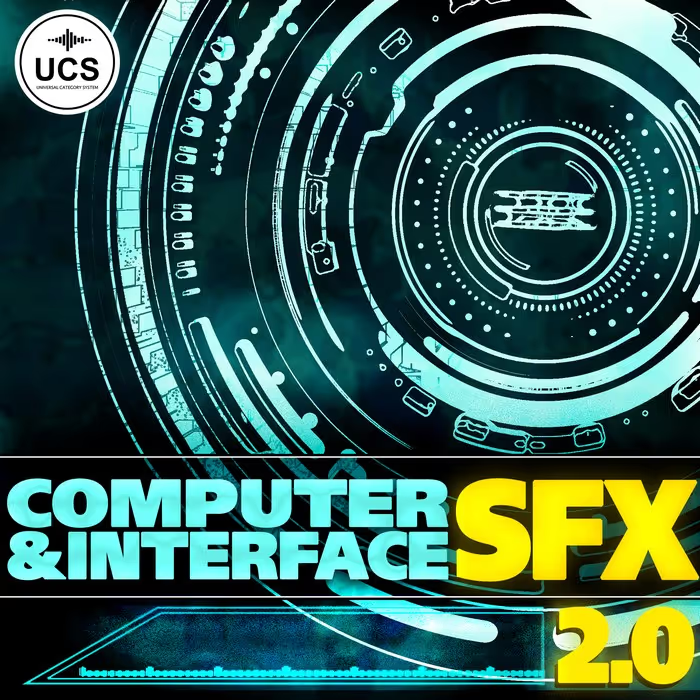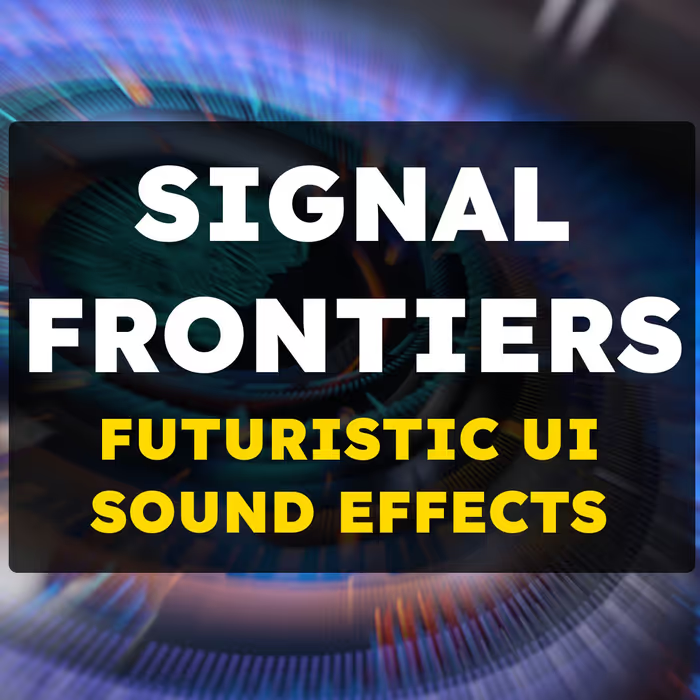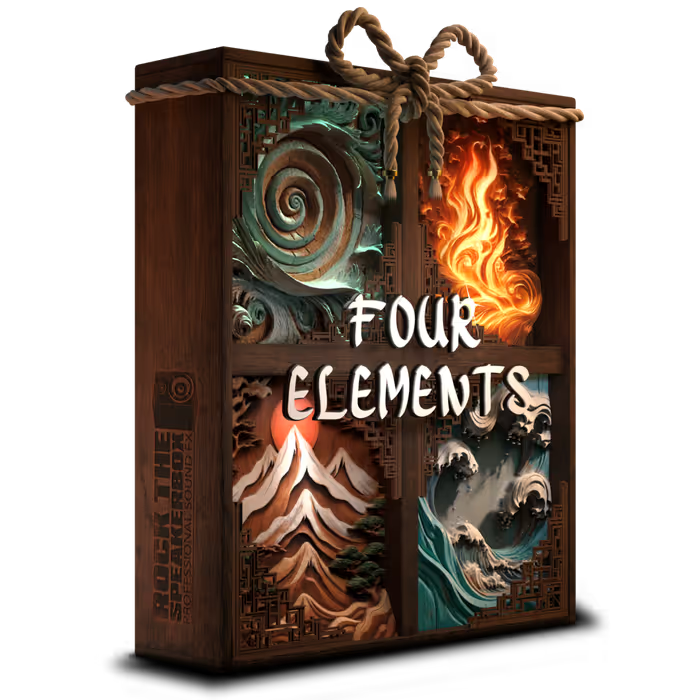And not only that: Veteran sound designers Mark Camperell, Jason Cushing and Ivo Ivanov also share their key advice on what makes for great sci-fi UI sound design, their favorite design techniques and go-to tools. Happy designing!
Written by Ruslan Nesteruk, images courtesy of Nawaz Alamgir. Additional insights by Mark Camperell, Jason Cushing and Ivo Ivanov.
With the booming development of technologies and their ubiquity in our lives, it is hard to imagine the world without the interfaces. As we are trying to keep up with the ever-expanding set of functions and information by creating new methods of control, a multitude of ordinary clicks, swipes, and scrolls inevitably finds its way into the everyday media. The science fiction genre, as the best reflection of our advancement, naturally hinges on something already existent, and takes it further, in constant attempts to ponder the future. While user interface sound design in itself is a subject no article can cover sufficiently, this article tries to discuss genre specific sound, in a way that some practices from industrial and software sound design are mentioned. Ultimately, there is no right or wrong in sci-fi sound design and the article is a collection of tips and observations shared with the community.
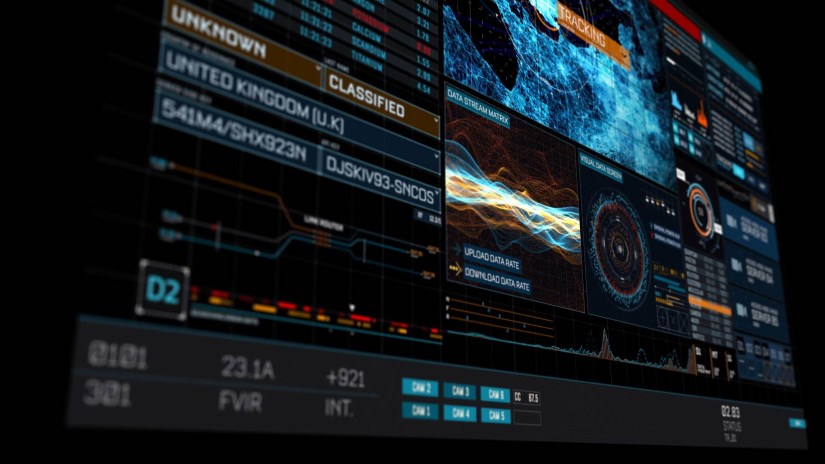
What sets sci-fi user interfaces apart?
The sound for sci-fi interfaces should be informative, relevant and appropriate
Despite the majority of sci-fi interfaces being based on established concepts of human interaction, sci-fi is a subgenre of Fantasy, and although it cannot offer an entirely different viewpoint on user interfaces, the range and dissimilarity of imagined controls can stretch pretty far.
This new variety of screens sliding in and out, appearing holograms, structural maps constructing in thin air, and many more others, begs to be sonified in a meaningful way. The sound, if it fits an interface function, asserts this alternate reality and further convinces viewers. Thus, there is a need to be able to adapt our knowledge of data sonification and sound generation techniques to fit the envisioned interaction of the future.
As mentioned above, the sound for sci-fi interfaces should be informative, relevant and appropriate, but what really makes sci-fi UIs stand out is the timbre and “extended” sonic analogies. Not many real life interfaces can boast organic alien gurgling or glassy granularized sound textures as a response to user control. Even then, usually there are certain analogies in these sounds that help us to make sense of all responses.
What makes for great UI sound design:
Informativeness – the choice of sound to reflect the state of an interface element, the capacity of effectively conveying the information both for visible UI element and as an auditory display. What if we have three identical buttons, but only one can backfire with a negative response to action while there is no apparent visual cue to inform us of the result of the action? Additionally, a message behind various UI sounds should be clear to others, not just sound designer.
Relevance/aesthetics — the quality of a created sound design to reflect and complement the UI visual style, the feel of it, its physical properties and dynamics. For example, a big blinky plastic knob on a derelict space ship control console would sound better with a heavier, meatier click sound that could be made from the recordings of old gear like tape machines and 35 mm cameras. On the contrary, a modern “flat” user interface would benefit from light, transparent, and often synthetic sounds. Sound can tell a lot about the object it represents.
Propriety – an important quality of any good UI sound design is in a general sense being appropriate to the environment/scene it’s in without being too obtrusive and messy. Just the right amount of sonic feedback for an interface: prioritized sounds over a meaningless barrage of beeps.
[tweet_box]How To Design Superb Sci-Fi UI Sound Effects[/tweet_box]
Conceptualizing:
While there are areas of sci-fi sound design that already have pretty established conventions of how they sound and are made, it is somewhat harder to pinpoint the backbone of a good sounding user interface. Apart from stereotypical beeps and bloops that have been used since around 1960s, sound design began to develop its new vocabulary to keep up with the graphics. Let’s see what goes into designing a futuristic interface and where to start.
• Priority
So, you’re tasked with creating sound for a futuristic user interface. Deciding on how important your interface sound will be depends on the medium and a setting, and from there it’s easier to estimate the overall complexity, informational density, and precision the sound design needs. Is it interactive or not? How often it is used/shown in the movie or game? How many elements does the interface have? How close can you see those elements? All these parameters help to establish the amount of priority an interface has in any given medium, and logically the amount of work.
• Structure
If the interface is visual, write down a list of elements that need sound. Note their function, size relative to other elements, how they act/move. Think how easily they can be created: is one tool enough? Will there be any organic recordings involved? This will help work out what you will need to create the sound design, so you can plan your work accordingly.
• Character
Logically, the next step is choosing the character. Is it a grungy sci-fi interface, or a sleek modern one? Is it tactile? Is it alien or human technology?
Try to match those qualities with sounds that either directly correspond or can represent them. For example, grungy abandoned spaceship console sound can be distorted, saturated, glitchy — something that is related to degradation, corrosion, and fragmentation in the audio domain. Similarly, other qualities like physicality or weight can be nuanced by varying the amount of low frequency and adding real sounds.
Passengers (2016) movie
One of the best set of UI sounds I’ve heard. Everything on the spaceship – from screen beeps to hall announcements – sounds clearly calm and pleasant, emphasizing that the spaceship is a high-tech cruise liner for wealthy individuals, and nothing can go wrong.
Dead Space 3
Notice how clearly the sound corresponds to appearing/dissapearing note saying “Artifact discovered”. The same goes for other game elements like activating the navigator or grabbing some ammo.
No Man’s Sky
Very clean and balanced UI sound design. “Negative response” sounds are clear and the screen swipes have a perfectly fitting sound. Overall it sounds light and unobtrusive.
Deus Ex: Mankind Divided
The game has great UI sound design that’s undecorated and masculine, but serves the game well.
Halo 5
The Halo series is an iconic example of science fiction: weapons, transportation, UI, and all other areas sound just like they should be. All user interfaces, either in cutscenes or in-game, are no exception. You can definitely understand and discern sounds for holograms, scanning, and any other UI action without even looking at the screen.
Designing:
If visual interface can be seen as a map, then its audio part is a language. A language full of different meanings conveyed via various prompts, confirmations, error messages and many more. As any language, UI sound design relies heavily on semantics, which can be created by either utilizing the existent analogies, or a set of new metaphors to which a viewer can be quickly and painlessly introduced. Sound designers have many sound parameters at their disposal to sculpt any noise into a meaningful representation of interface elements:
• Frequency/Pitch
• Amplitude
• Timbre
• Direction
• Positive/Negative (consonant, dissonant)
• Short and snappy or long and smooth
Any of these parameters can represent certain interface states or data changes and become that analogy. A speedometer scale goes up, and the sound goes up in pitch along with it.
Thinking of these “movements” is a good way to start sketching out your interface design
Or the wrong button is pressed and the edgy, discordant sound is spit out. Thinking of these “movements” is a good way to start sketching out your interface design. The metaphors can use any combination of the parameters, and to make sure that the interface will be understood by others, just listen to the result once again and ask yourself: “Does this sound like the target element?”
If you need futuristic sounds to work from – or ready-made sounds -, here’s a selection of dedicated SFX libraries:
Find more material in the User Interface (UI) sound category
A good example of mapping sound to information would be the mining minigame in the old Mass Effect 2 game. In the game you need to find resources all around a planet and launch probes to collect them. Along with the graph that shows you the amount of four resources, the sound is used to reflect that information by using two qualities: timbre and periodicity of clicks. The timbre is used to identify which mineral you have stumbled upon, and the clicks occur faster when the amount is bigger. In this particular case the solution helps users to watch where the scanner on a planet goes without concentrating too much on the “amount graphs”.
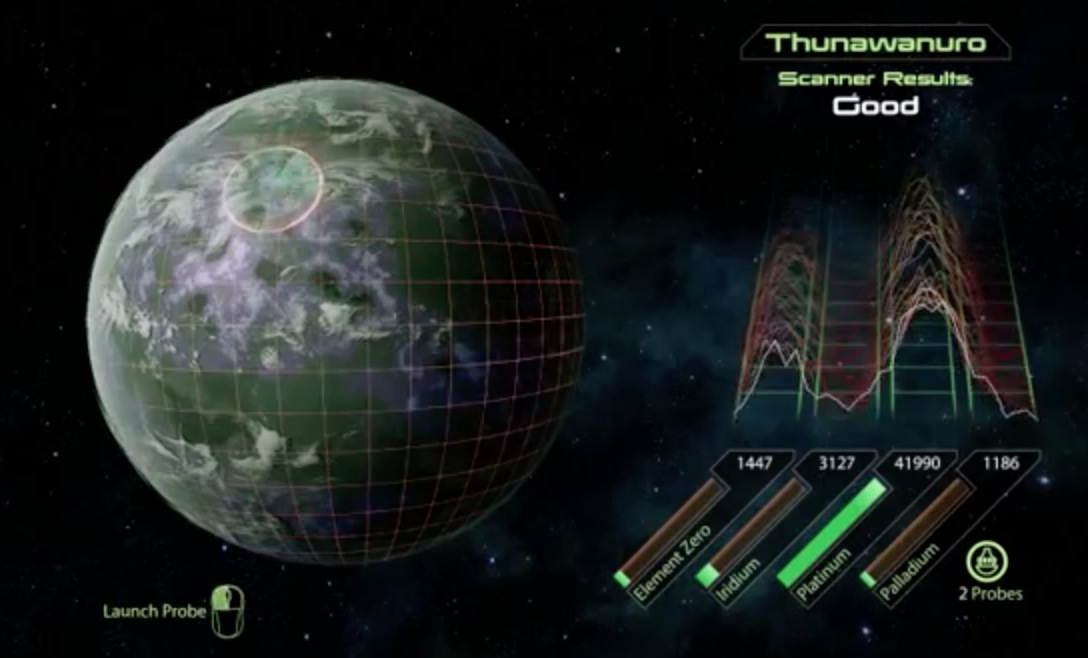
Screenshot from the Mass Effect 2 mining minigame
The sounds below are from Digital Rain Lab’s ‘Signal Frontiers’ library, which was made using only a few similar/related techniques to yield cohesive sonic results across hundreds of files.
0:00: initialization/open interface
0:01: computation/loading
0:03: dialog window opened
0:04: typing/pressing buttons
0:05: processing request/scanning
0:06: denial/negative response
0:07: entering the query again
0:08: operation successful
0:08: a few more button presses to close the dialog window. dialog window closes
0:10: whole interface/hologram shuts down
Let’s look at some tools that help shaping the sound:
Envelopes – one of the essential controls. An envelope is what shapes the sound over time and can be assigned to amplitude, frequency, timbre, and many more. If you already have the idea what your design should sound like, envelopes are a first stop to experiment with, and there is a good chance you will get 50% of the job done.
Filters – while you can approximate the interface “actions” with pitch and amplitude, filters are no exception in the toolbox. Sometimes it is necessary to create a sweep across the whole spectrum or give some movement to certain frequency bands. Filters work great in creating opening/closing interfaces or making scanning sounds but can be used for anything.
Modulation – another effective technique. From generating a variety of sounds with FM/AM synthesis to modifying continuous/cyclic sounds with phase and ring modulation. Equally good for spicing up the final design.
If you want to learn more about sci-fi sound design, check out these guides:
• How To Design Supreme Sci-Fi Weapon Sound Effects
• How To Design Stellar Spaceship Sound Effects – an Essential Sci-Fi Sound Design Guide
LFO – also a kind of modulation that can be applied to any parameter in your system to create cyclic variations. Extremely useful in making scanning/checking/computation sounds, basically anything continuous in nature.
Delay – from timbre-altering comb delays and sound-mutating granular delays to the nice subtle ping pong and echo delay, delay quite often is a solid inclusion in an effect chain.
Reverb – no sound should be presented without spatial information. Reverberation instantly puts a sound into an environment and makes it sound sweet and natural.
These effects and techniques can get you closer to the sound you’re after, but sci-fi is a bit like looking into the future, so sound designers are always in search for new sonic expression methods. Experiment with resynthesis, cross-convolution, stretching, and shifting — the sky is the limit (then warp drive far beyond).
A button … can be made literally out of anything: a sine tone, a recorded mouse click, a metal bang, or even a millisecond long snippet of your favorite song
As for the sound generation itself, there are no particular best techniques for making a sci-fi UI sound design. The beauty of UI sound design is that every waveform, every type of synthesis, and every recorded sound can be molded into something that works. A button, for example, can be made literally out of anything: a sine tone, a recorded mouse click, a metal bang, or even a millisecond long snippet of your favorite song. Identify the direction of your sound design, and work your way up by using particular timbres, sound textures and effects.
While it also may seem like designing interface sounds is easy, good designs are often hard to achieve. The sounds are typically short, and getting the right sound character is a bit of a challenge. Layering helps to articulate the function and enrich the tone, which may benefit the final design and its sonic uniqueness. Experiment: layer sounds with different frequency bands, add organic textures to synthetic sounds, split and add effects, etc. The ideal sound should be sophisticated but clear (sound and meaning-wise) unless the ultimate simplicity is the goal.
Mark Camperell
UI Sound design insights from Mark Camperell from Empty Sea Audio, sound designer on countless series such as Arrow and The Flash – and creator of the Ui One library:
The key to great sci-fi UI sound design: I believe that there are three keys to great sci-fi UI sounds. First, the sounds need to fit within the visual design and motion of what the audience is being presented with. Second, the sounds need to give proper feedback to the audience so they are able to better understand why the UI is behaving in such a manner. Story being of utmost importance here. Third, the sounds need to be rewarding and pleasing enough to keep the audience coming back for more.
The end result of the visual and auditory experience shouldn’t feel like this department versus that department. It should feel like one complete product
Great UI sounds should result in the audience never turning the sounds off. They are a part of the design of the game/film/whatever. The end result of the visual and auditory experience shouldn’t feel like this department versus that department. It should feel like one complete product.
Favorite techniques and tips for creating sci-fi UI sounds: The sounds shouldn’t clash with the music, unless intended to do so in order to create a different feeling. It’s always good to create with the score or mix with the score so you can check if you have any unintended dissonance between the elements. Pitch shifting and vari-speeding can be your friend in this instance.
Go-to tools for UI sound design: My absolute favorite tool is my Telecaster. It can be used to create a variety of tones, whether transient or smooth that can be easily manipulated later into something completely unique and new. The best part of using musical instruments to create sci-fi UI is that it can make it easier to tune the sounds to the key of the music. Other tools I like include synths, samplers, reverbs, eq, etc… GRM Tools is an effective plugin suite for creating sci-fi UI, as is Twisted Tools S-Layer.
Jason Cushing
UI Sound design insights from Jason Cushing, co-founder of SoundMorph, makers of releases like Users of Tomorrow, Galactic Assistant and many (many) more:
The key to great sci-fi UI sound design: The Sci-Fi genre has always been one of my personal favourites. Not only is it about worlds and cultures unknown, but it is also very creative. The genre itself is always pushing for new philosophies in how we view the universe, ourselves, time and space, and life in general.
The key to great sci-fi UI sound design is opening up your mind to the possibilities of unknown technology
It’s a vastly unlimited and creative area where there are no real absolute truths. So that leaves a world of opportunity for a sound designer to really explore things like “what would this technology sound like?” When you have that freedom, it’s exciting. So to me, the key to great sci-fi UI sound design is opening up your mind to the possibilities of unknown technology…it is whatever you want it to be, so uniqueness that might relate to the project you are working on is a key factor.
Favorite techniques or tips for creating sci-fi UI sounds: When I was starting out in sound design, UI sound design seemed like this mystery thing that I just couldn’t wrap my head around. I remember thinking “how the heck do they make those sounds?!” But as I spent more time understanding sound and designing these type of things, Sci-FI Ui sound design is actually not too hard to create. It can be purely synthesized or chopped up audio, real recorded materials like glass or metal, or a combination of real life recordings and synthesis. A good place to start is to watch a large handful of your favourite sci-fi films and then start out by trying to emulate some of the sounds they made. Once you master some of that, then you will have your own sense of what you like, and can start to form your own unique sounds too. It’s like current rockstars being influenced by all of their favourite bands. They absorb that influence and then make something all their own.
Go-to tools for UI sound design: Usually I gravitate towards glitchy or granular type plugins. Kyma is also a great tool if you have the time and money to learn it. The Reaktor user community is also an excellent place to start and find tools that most people don’t even use or have never heard of. There is a huge community of talented Reaktor builders making some really cool stuff. I love Glitchmachines and Twisted Tools software and Reaktor ensembles for this type of stuff. I also love “The Mangle” by Sound Guru. As far as SoundMorph goes, of course we have our Galactic Assistant standalone and Reaktor software… which is a basic Sci-fi UI designer. It was in fact the first software tool we ever made! We have talked about making a Galactic Assistant 2, with much more in-depth features for synthesis and sample use as well. So hopefully some day we can make that for you all.
Ivo Ivanov
UI Sound design insights from Ivo Ivanov, founder of Glitchmachines, and creator of a series of outstanding futuristic sound effects libraries:
The key to great sci-fi UI sound design: For me it’s all about the details. Especially in UI design, I feel that articulation is everything. It’s not only about precision, however, because there are all types of user interfaces so when I think about UI, I think it’s crucial to consider the bigger picture. For example, you would approach an organic, physical UI much different than a synthetic, digital one.
Most of all, I always consider how a UI actually works, rather than just making a cool sound to match with it
So, first and foremost, it’s important to establish the aesthetic direction of the design. This allows me to determine what kinds of building blocks I will need and from there, I can begin to construct my sounds from a more mechanical standpoint. I consider all attributes of architecture and motion, and mentally dissect the respective mechanism to its core. This allows me to make critical decisions about the design, and also gives me the opportunity to take inventory of what elements need to be in the foreground, background, etc. It’s also important to be sensitive to feedback cues such as positive/negative reinforcement that may be necessitated by elements in a game, for example. Most of all, I always consider how a UI actually works, rather than just making a cool sound to match with it.
Favorite techniques or tips for creating sci-fi UI sounds: I like to start with things like electromagnetic source recordings, modular synth articulations, mechanical source recordings of small motors, tools and just about any kind of device or contraption I can find or even build myself if necessary. This makes it possible to go a lot further than the typical beeps and stuff you can generate in the computer and it adds a vivid realism to the designs that I find is difficult to achieve in another way. This is my approach in general when it comes to my style of sound design; start with something that already resembles where I want to take a sound and then process, layer and sculpt my way toward the final result. You could say that this is my way of working with nature rather than against it. In that respect, I pay just as much attention to the creation and recording of the source material as I do to the processing.
This is my approach in general when it comes to my style of sound design; start with something that already resembles where I want to take a sound and then process, layer and sculpt my way toward the final result
Of course the key to this approach is to constantly develop my personal library of source material. I’m always listening and recording every possible resource, and I spend a lot of time on fine-tuning my Foley skills to the extent that I find it critical to be sensitive to how sounds are “performed” with objects. This is something I would recommend to any sound designer whether we’re talking UI sfx or whatever else. The cooking analogy is my favorite; you wouldn’t attempt to cook a gourmet meal for 10 guests without plenty of ingredients, so why would you try to design sounds without any source material? Of course there will be times when you must simply work from the ground up, so to speak, but this is typically not my personal approach or preference.
Go-to tools for UI sound design: I try to avoid too many go-to tools in the studio in general because in my experience, this tends to be the fastest way to arrive at my comfort zone, which in turn tends to hinder my ability to create anything fresh. Instead, I like to approach new projects (time permitting, of course) in a completely clean way which starts with deciding what tools and techniques I will utilize that I haven’t used before. Naturally, it’s not possible to begin every project with a completely new set of tools, but if I’m able to introduce even one new element into my workflow, that’s typically enough to stimulate new ideas.
I try to avoid too many go-to tools in the studio in general because in my experience, this tends to be the fastest way to arrive at my comfort zone, which in turn tends to hinder my ability to create anything fresh
For me, this overall approach is a great way to induce some excitement into my process, because when I’m trying new things in a new context, it almost always leads to new discoveries and thus, fresh content. Additionally I try to match the scope of a project with the right tools, because it’s generally very important to consider how many sounds you have to make within a given theme. The difference between creating 10 sounds vs. 1000 sounds will certainly guide my decisions concerning which tools are going to be the best fit for a particular project. With all this in mind, I could certainly list the same old lineup of plugins and tools we all tend to use but I think the best approach is to force yourself out of your comfort zone and try something new whenever you can.
To sum up, the science fiction genre is a vast universe and user interfaces are integral to authenticity, narrative, and experience. Although the diversity of interfaces and their elements can be overwhelming and stripped of any real reference, there are proven ways to match UIs with sound, manipulating a number of sound properties and shaping with different tools. Along with adding up to the aesthetics, UI sound design also reflects information and contributes to a story, via timbre, periodicity and a range of subjective qualities. Great sci-fi UI sound is always informative, relevant, appropriate, and innovative in character. Experimentation is the key to nailing an interesting sounding user interface: synthesize, record, layer, mix, and match.


